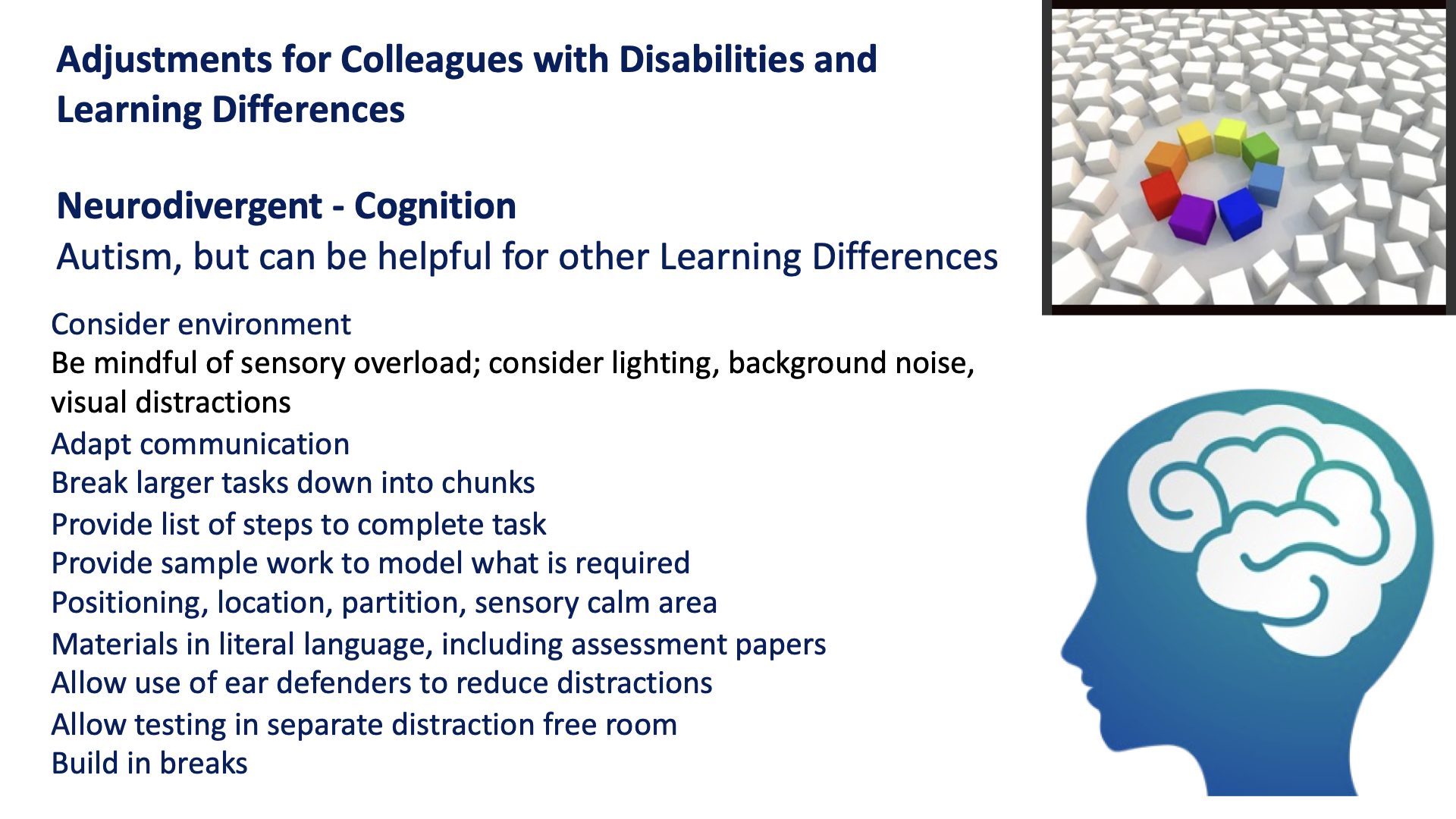Supporting Every Ability:
Neurodiversity at Work
- All breakout activities for today can be found on this page.
- Please keep the tab open for ease.
- Scroll to each new activity when the time comes.
- Please make sure that all voices are heard and select a speaker, when required, to share a summary of what has been discussed.
Breakout Activity One:
Reflect and Discuss - Celebrating Good Practice
Neuro-Inclusion
Instructions
• Your leader for this activity will be the person who was born in the earliest month of the year
• Your leader will select a speaker for the team, who will share a brief summary of what was discussed. If you prefer not to speak, choose another colleague
• Your Leader will guide you through the questions below.
• Make sure that all voices are heard - consciously include all members of the team!
In relation to Neuro-Inclusion:
Team One (Room One)
- What do you and your team already do well but could do more consistently?
2. Is there anything you'd like to do better? What could you do to be more inclusive?
Team Two (Room Two)
- What do we mean by accessibility and removing barriers?
2. Are we getting it right with regards to accessibility?
A) For colleagues
B) Candidates

Breakout Activity Two:
Receptive/Expressive Communication Activity
Instructions
- The person whose name is last alphabetically will be the leader of this activity.
2. Your leader will decide who will be Speaker A and who will be Speaker B.
3. Your leader will guide you through each part of the activity below:
PART ONE
In a moment, SPEAKER A is going to talk for one minute about their weekend and SPEAKER B is just going to listen.
OK – off you go [1 minute].
And stop!
How did that feel? Easy? Good!
PART TWO
Now, SPEAKER B is going to talk about their weekend for one minute. BUT they are not allowed to use any words containing the letter ‘e’.
Ready? Off you go! [1 minute].
And stop!
How did that feel?
Were you able to speak as fluently as your partner?
How did that make you feel?
SPEAKER A - how did it feel listening as your partner was struggling to put their thoughts into words? Frustrating? Annoying?
Discuss:
What was the purpose of this exercise?
How might it relate to your role?

Breakout Activity Three: Staff Case Studies
Instructions
Case Study One (Room One)
Case Study Two (Room Two)
Case Study Three (Room Three)
Case Study Four (Room Four)
Your
Leader
will be the person
born latest in the year.
The Leader will guide you through the activity, ensuring all voices are heard.
- Discuss assigned Case Study and
2. Consider the related Discussion Prompts
3. Suggest Practical Tips
4. Select a speaker to share with wider group
Some helpful links to assist with this activity:
ACAS information on Reasonable Adjustments
Case Studies
Case Study 1: James – Software Developer/ ADHD
James is a talented software developer who consistently generates innovative ideas. He thrives under pressure and enjoys problem-solving, especially when tackling complex coding challenges. His energy and enthusiasm are contagious, often motivating the team.
However, James struggles with maintaining focus during long meetings and can become distracted by notifications or side conversations. He sometimes misses deadlines because he underestimates how long tasks will take. His manager has noticed that while his individual contributions are excellent, his project documentation is often incomplete.
Strengths:
- Creative thinker, excellent at generating solutions.
- Thrives in fast-paced, high-pressure situations.
- Motivates and energises others.
Challenges:
- Difficulty sustaining attention during lengthy tasks or meetings.
- Time-management issues and missed deadlines.
- Incomplete documentation of work.
- How can James’s creativity and enthusiasm be harnessed more effectively in the team?
2. What adjustments could help James stay on track with deadlines and documentation?
3. How might supporting James also improve productivity for the wider team?
Case Study 2: Priya – Customer Support/Autism
Priya has worked in Customer Support for two years. She is known for her attention to detail, accuracy in data entry, and ability to follow scripts precisely. Customers appreciate her calm and polite manner, and she has one of the highest call-resolution rates on the team.
Priya struggles when unexpected questions arise outside of the script, and she becomes visibly anxious during unstructured team discussions. She avoids social gatherings and prefers to take lunch alone, which some colleagues misinterpret as unfriendly. Changes to her shift pattern without advance notice cause her stress.
Strengths:
- Highly accurate, detail-oriented, reliable.
- Excellent consistency in following processes.
- Calm and polite in customer interactions.
Challenges:
- Difficulty handling ambiguity and unexpected changes.
- Anxiety in unstructured group settings.
- Limited social interaction with colleagues.
Discussion Prompts
- How might colleagues misinterpret Priya’s behaviour, and what could be done to prevent this?
- What steps could reduce Priya’s anxiety during unexpected changes or unstructured discussions?
- How can the manager balance Priya’s need for routine with the needs of the business?
Case Study 3: Ahmed – Finance Analyst/Dyslexia
Ahmed is a finance analyst who is strong in verbal communication and excels at seeing “the bigger picture.” He often identifies strategic patterns and risks others miss, and his presentations are clear and engaging.
However, Ahmed finds written tasks challenging. He struggles with spelling and grammar in reports, which sometimes undermines the professionalism of his work. He is hesitant to volunteer for written tasks in team projects, fearing judgement. Ahmed often works longer hours than colleagues to double-check his reports.
Strengths:
- Strategic thinker with strong verbal communication.
- Excellent at spotting patterns and trends.
- Clear and engaging in oral presentations.
Challenges:
- Written communication errors in spelling and grammar.
- Anxiety about colleagues’ perceptions.
- Works longer hours to compensate for difficulties.
Discussion Prompts
- How do Ahmed’s strategic thinking skills benefit the team?
2. What risks might arise if Ahmed continues to overwork to compensate for his difficulties?
3. Which practical tools or team approaches could reduce Ahmed’s stress while showcasing his strengths?
Case Study 4: Sarah – Project Manager/Tourette Syndrome
Sarah is a capable project manager with strong leadership skills. She coordinates complex projects effectively, ensuring team members understand roles and deadlines. She is proactive, approachable, and well-liked.
Sarah also experiences motor and vocal tics that sometimes appear during meetings. While her colleagues are generally supportive, she has confided in her manager that she feels self-conscious and worries about being judged. Occasionally, clients ask questions about her tics, which leaves her feeling embarrassed.
Strengths:
- Strong leadership and coordination skills.
- Proactive and approachable team player.
- Highly effective at ensuring projects run smoothly.
Challenges:
- Visible motor and vocal tics that draw unwanted attention.
- Anxiety about others’ reactions.
- Emotional fatigue from self-monitoring in professional settings.
Discussion Prompts
- How can Sarah’s leadership be recognised and reinforced while addressing her concerns about stigma?
2. What should the manager do if clients or colleagues react negatively to Sarah’s tics?
3. How might increasing awareness of Tourette Syndrome improve team culture and inclusivity?
Additional Case Studies for Extended Learning
- Charli is incredibly effective in their role as an Executive Secretary, having built trust and rapport with colleagues across the organisation, and has never believed their dyslexia to be an obstacle. However, recent changes in recording and reporting procedures have caused some anxiety. This has been brought to your attention and you must decide on the advice, support you will offer:
- 1.Charli
- 2.Charli’s Manager
2. Jo is a newly recruited Finance Officer, with so much energy and enthusiasm for their role, and is already achieving great results. Jo has lots to say but often doesn’t seem to listen to others, loses focus, and gets side-tracked.
When it comes to organising paperwork, Jo seems more reluctant. At a recent Internal Review, some important data had gone missing, and this has caused some concern for their Line Manager.
1.What advice can you offer Jo’s Line Manager
2.What practical support can be offered to Jo?
3. Ademola, is a highly efficient and thorough IT Assistant, who has been with the organisation for many years.
He is autistic and thrives when there are clear rules and routines but finds the unstructured parts of the day difficult. New changes to working conditions, in particular open office and hot-desk requirements have caused him to become visibly upset.
How can we support Ademola? What can be put in place?
Please scroll below these Case Studies to find further guidance and examples of Adjustments.





Additional Breakout Activity:
The Employee Lifecycle from an HR perspective
• Recruiting & Interview (Room 1)
• Performance Management (Room 2)
• Career Development (Room 3)
With a neuro-inclusive approach:
Discuss ways to enhance the experience of underrepresented candidates/colleagues and give an examples of what good looks like.
What would an inclusive leader do to demonstrate fair and equitable treatment of neurodivergent staff?
This might be something that you’ve experienced or something that you yourself do.
• Recruiting & Interview (Room 1)
• Performance Management (Room 2)
• Career Development (Room 3)
















